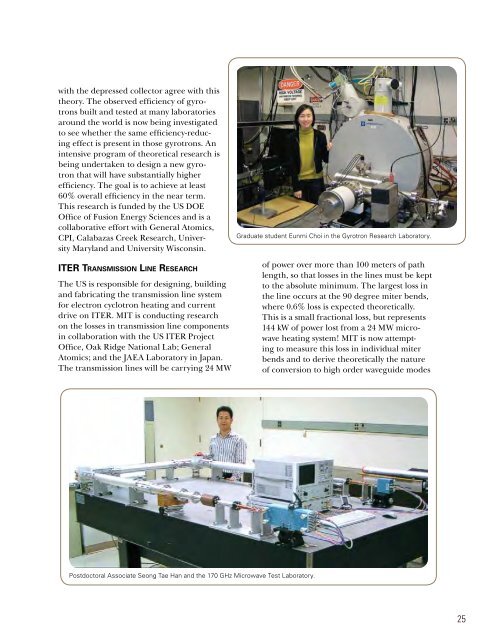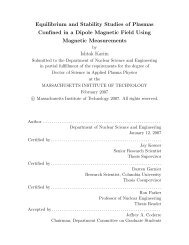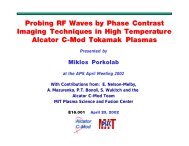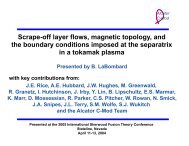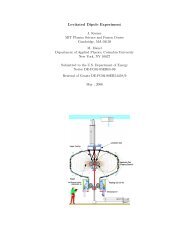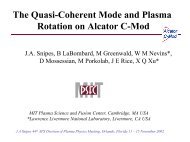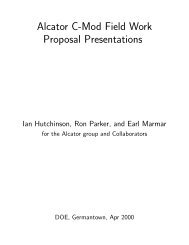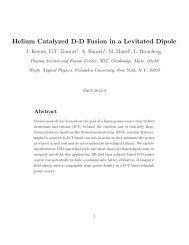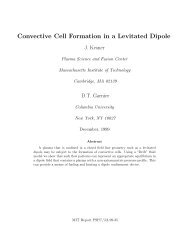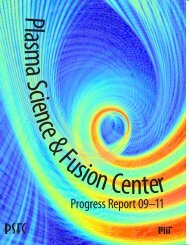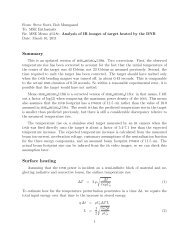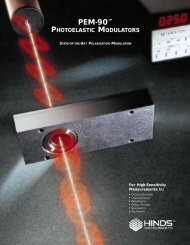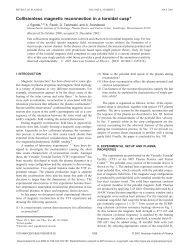From the Director - Plasma Science and Fusion Center - MIT
From the Director - Plasma Science and Fusion Center - MIT
From the Director - Plasma Science and Fusion Center - MIT
You also want an ePaper? Increase the reach of your titles
YUMPU automatically turns print PDFs into web optimized ePapers that Google loves.
with <strong>the</strong> depressed collector agree with this<br />
<strong>the</strong>ory. The observed efficiency of gyrotrons<br />
built <strong>and</strong> tested at many laboratories<br />
around <strong>the</strong> world is now being investigated<br />
to see whe<strong>the</strong>r <strong>the</strong> same efficiency-reducing<br />
effect is present in those gyrotrons. An<br />
intensive program of <strong>the</strong>oretical research is<br />
being undertaken to design a new gyrotron<br />
that will have substantially higher<br />
efficiency. The goal is to achieve at least<br />
60% overall efficiency in <strong>the</strong> near term.<br />
This research is funded by <strong>the</strong> US DOE<br />
Office of <strong>Fusion</strong> Energy <strong>Science</strong>s <strong>and</strong> is a<br />
collaborative effort with General Atomics,<br />
CPI, Calabazas Creek Research, University<br />
Maryl<strong>and</strong> <strong>and</strong> University Wisconsin.<br />
ITER Transmission Line Research<br />
The US is responsible for designing, building<br />
<strong>and</strong> fabricating <strong>the</strong> transmission line system<br />
for electron cyclotron heating <strong>and</strong> current<br />
drive on ITER. <strong>MIT</strong> is conducting research<br />
on <strong>the</strong> losses in transmission line components<br />
in collaboration with <strong>the</strong> US ITER Project<br />
Office, Oak Ridge National Lab; General<br />
Atomics; <strong>and</strong> <strong>the</strong> JAEA Laboratory in Japan.<br />
The transmission lines will be carrying 24 MW<br />
Graduate student Eunmi Choi in <strong>the</strong> Gyrotron Research Laboratory.<br />
of power over more than 100 meters of path<br />
length, so that losses in <strong>the</strong> lines must be kept<br />
to <strong>the</strong> absolute minimum. The largest loss in<br />
<strong>the</strong> line occurs at <strong>the</strong> 90 degree miter bends,<br />
where 0.6% loss is expected <strong>the</strong>oretically.<br />
This is a small fractional loss, but represents<br />
144 kW of power lost from a 24 MW microwave<br />
heating system! <strong>MIT</strong> is now attempting<br />
to measure this loss in individual miter<br />
bends <strong>and</strong> to derive <strong>the</strong>oretically <strong>the</strong> nature<br />
of conversion to high order waveguide modes<br />
Postdoctoral Associate Seong Tae Han <strong>and</strong> <strong>the</strong> 170 GHz Microwave Test Laboratory.<br />
25


